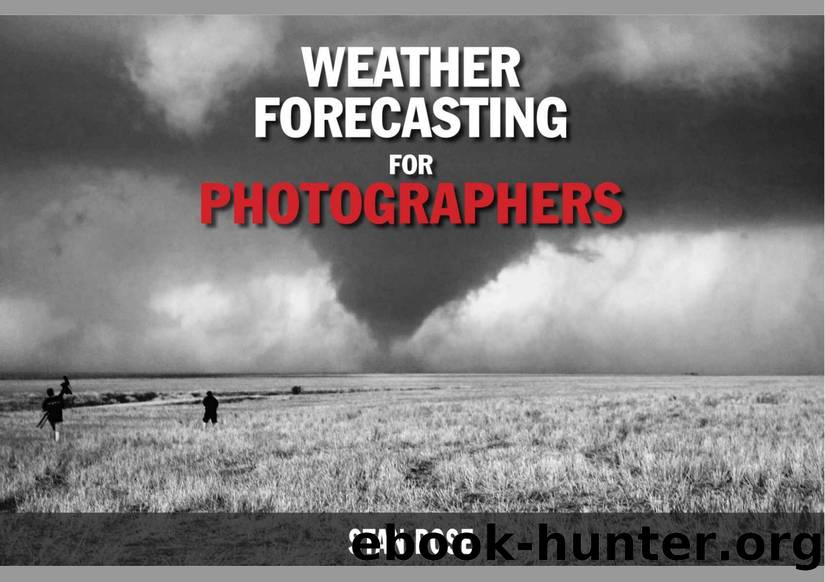Weather Forecasting for Photographers by Stanley Rose & Stanley Rose

Author:Stanley Rose & Stanley Rose [Rose, Stanley]
Language: eng
Format: azw3
Tags: Keywords
Publisher: Stan Rose
Published: 2018-10-17T16:00:00+00:00
USING THE SKEW-T
Figure 33.
The skew-T diagram (Figure 33) is named for the fact that temperature, T, on the âxâ axis of the chart is on a diagonal as opposed to straight up and down. This allows for a nice vertical plot of temperature in relation to altitude, which is given as a logarithm of pressure on the âyâ axis. Here is the skew-T for a point just west of Gunnison, Colorado, for the same time (2 PM, a 33 hour forecast off the 12Z NAM) in southwest Colorado. I obtained this chart by simply clicking on the map of humidity with my mouse at that point (Twisterdata.com was one of only a few sites on the internet that let me do this, and it is a very powerful tool!).
Temperature is the red line on the right side of the chart. Dew point, the temperature that the air would have to be cooled to in order to produce condensation, is on the left. It will always be to the left of the temperature line (or coincident). The blue line in between is the wet bulb temperature, and represents the temperature that air would be cooled to if liquid water is evaporated into the air (as photographers, you will rarely if ever need to worry about wet bulb). Wind barbs, or flags, are shown on the right side of the diagram, at the standard atmospheric levels of pressure. Your main focus in this diagram should be to look at how the temperature and dew point lines are related. If the dew point line matches the temperature line, the air is saturated with water vapor, and clouds will likely be forming. If the two lines are far apart, then the air is very dry (relative humidity is low). Dew point is directly related to how much moisture is in the air, and so relative humidity rises as the dew point approaches the temperature.
In the diagram, the lower levels are dry, as one would expect from the previous chart of relative humidity. Therefore, no clouds should appear. Above 500 mb, however, the lines approach each other. this occurs around 450mb, or 6,500 meters (meters are conveniently given to the right of the pressure hereâthat will not always be the case in a diagram like this). 6,500 meters is roughly 20,000 feet, so any clouds here will be high clouds, probably types of cirrus. Note that the lines never touch, so relative humidity is not 100%, it is somewhat less than that. From the flat plot of humidity at 300mb, we can estimate that it is somewhere in the 70-80 percent range. The humidity is relatively high straight up to 12,000 meters on the chart however, which suggests that there may be quite a bit of high-cloudiness, or possibly several layers. Now, lets see what really happened.
Photo 12
As you can see in the sky of Photo 12, which was taken at about 3 PM local time (22 UTC), there was quite a bit of high-cloudiness, in the form of cirrus clouds.
Download
This site does not store any files on its server. We only index and link to content provided by other sites. Please contact the content providers to delete copyright contents if any and email us, we'll remove relevant links or contents immediately.
Islands of Abandonment by Cal Flyn(483)
Where the Deer and the Antelope Play by Nick Offerman(419)
A Zero Waste Life by Anita Vandyke(378)
Second Nature by Nathaniel Rich(343)
How to Read the Weather by Storm Dunlop(319)
A Wild Idea by Jonathan Franklin(319)
Tomorrow's Economy by Per Espen Stoknes(318)
The Essential Wilderness Navigator by David Seidman & Paul Cleveland(258)
A Perfect Planet by Huw Cordey(248)
This Is Water by David Foster Wallace(248)
The Redemption of Wolf 302 by Rick McIntyre(248)
Wilderness Essays by John Muir(247)
The Reign of Wolf 21 by Rick McIntyre(238)
Pig Tales: An Omnivore's Quest for Sustainable Meat by Barry Estabrook(236)
The Emergence of Numerical Weather Prediction Richardson Dream by Peter Lynch(226)
Wildwood: A Journey Through Trees by Roger Deakin(212)
Weather Forecasting for Photographers by Stanley Rose & Stanley Rose(201)
Clouds by Richard Hamblyn(184)
Post-Growth Living by Kate Soper;(173)
